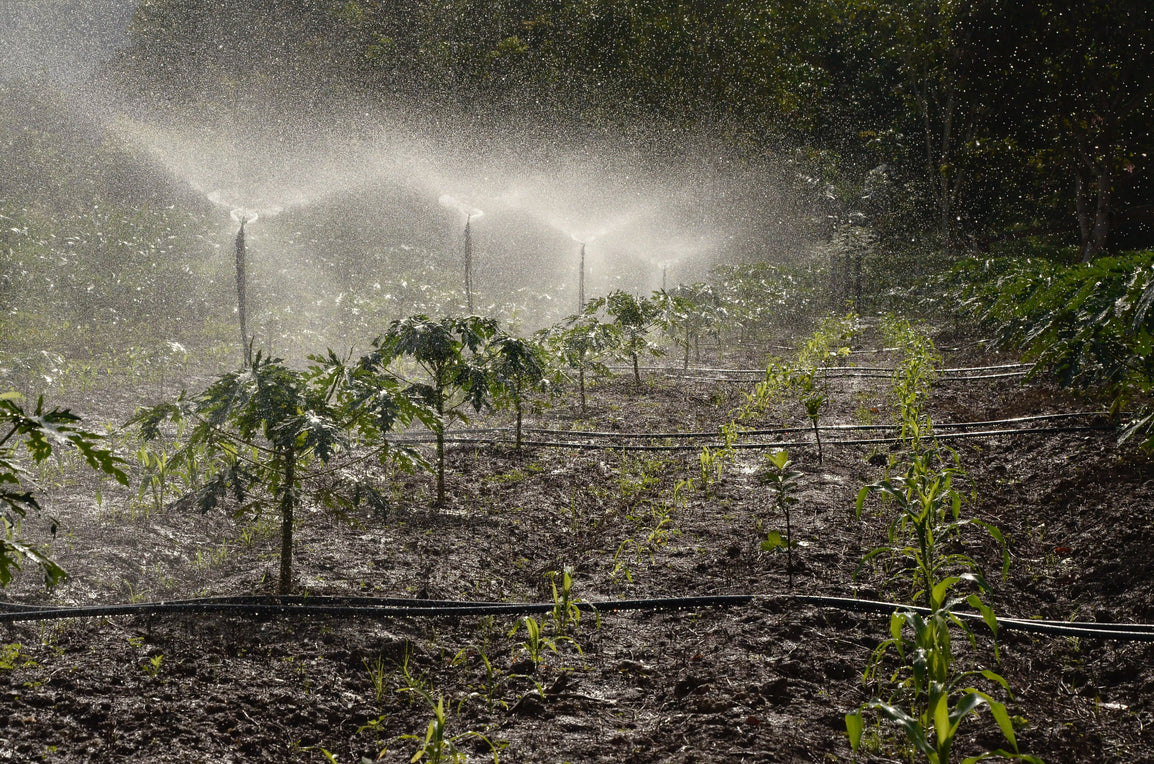THE CARNIVORE DIET BENEFITS





In an era where water scarcity and drought dominate the global conversation, the question of how we grow our food and manage our water resources has never been more critical.
Maybe you’ve begun to wonder how your dietary choices could impact not only your health but the health of the planet, especially concerning our water systems. Well, the answer lies in a powerful, yet underappreciated farming approach known as regenerative agriculture.
What if we told you that the food you eat can either contribute to the problem or be part of a promising solution? If that sparks your curiosity, then this is the perfect place to start. We invite you on this enlightening journey as we explore the profound water benefits of regenerative agriculture.
In this guide, we’ll bring you up to speed on regenerative farming and specifically highlight its remarkable ability to conserve - even replenish - our water resources. And, as you’ll soon find out, the water-specific benefits of regenerative farming are just the tip of the iceberg.
So, let’s dive in and discover how the future of farming holds the potential to quench the earth's thirst. Buckle up and get ready to plunge into the refreshing world of water-smart regenerative agriculture!
Understanding Regenerative Agriculture
Before we get into the main topic at hand today - pulling the curtain back on the water benefits of regenerative agriculture - we need to provide a bit of context for those who are new to the future of farming. So, what is regenerative farming?
Quick Primer on Regenerative Agriculture
This is a system of farming principles and practices that enriches the biodiversity of the soil, rather than depleting it.
It's an innovative approach that goes beyond sustainable farming. While sustainable agriculture aims to maintain the status quo, regenerative agriculture seeks to improve and restore the farming ecosystem.
How does regenerative agriculture work, though? There are various regenerative agriculture techniques that go into a thriving, holistic farming system. However, the main ones include:
- Minimal soil disturbance (no-till farming): This practice seeks to maintain the soil’s unique structure and leave it intact. As a result, key nutrients remain in the soil and are available to crops. And, microorganism health is upheld.
- Crop diversity and rotation: By planting various crops and rotating them seasonally, soil fertility is maintained and pest cycles are disrupted. This also leads to greater biodiversity.
- Cover cropping: Cover crops, or 'green manure,' are grown specifically to enhance soil health, improve fertility, control weeds, and increase water retention.
- Rotational grazing and incorporating livestock: Animals are moved around pastures to distribute manure evenly, aiding in grass growth and soil health. Their integration into crop systems further enhances soil fertility. You can learn more in our detailed guide on regenerative cattle farming.
Each of these practices contributes to a complex, healthy ecosystem where plants and animals all play their role. You can learn more about how to do regenerative agriculture in our blog - but for now, let’s take a closer look at how these strategies differ from the norm.
How Regenerative Agriculture Differs from Conventional Farming
Traditional or conventional farming methods, by contrast, often involve practices like mono-cropping (growing only one type of crop), tilling the soil, and extensive use of synthetic fertilizers and pesticides. These practices can lead to soil degradation, erosion, and reduced biodiversity.
Regenerative agriculture, on the other hand, views the farm as an interconnected ecosystem. It embraces nature's complexity and harnesses it to create a more resilient, productive, and ecologically balanced farm. Importantly, it considers the soil as a living entity - a dynamic community of microorganisms that need to be nourished and protected.
The contrast becomes more evident when we examine how each approach impacts our precious water resources. And that's where we're headed next. So, hold tight as we delve into the remarkable water benefits of adopting regenerative farming practices. You're about to see farming - and water - in a whole new light.
What are the Water Benefits of Regenerative Agriculture?
Water is life. Not only for us humans but for every organism on our planet. Therefore, any farming approach that we adopt needs to conserve and enhance our water resources. Luckily, regenerative agriculture does exactly that. Here are the water benefits of regenerative agriculture you need to know about.
Improved Water Retention and Reduced Runoff
Healthy soils are thirsty soils. When the soil is rich in organic matter and teeming with life, it can absorb and hold water much more effectively than degraded soils. Think of it as a sponge that soaks up water during rainfalls and slowly releases it when needed.
This capacity is especially important in areas prone to droughts as it helps farms remain productive even under drier conditions.
By reducing tillage, using cover crops, and diversifying plant life, regenerative agriculture enhances the soil structure and increases its organic matter content. This not only boosts the soil's water-holding capacity but also decreases water runoff.
In conventional farming, a lot of water simply runs off the fields, often carrying with it valuable topsoil and agrochemicals that can pollute waterways. But with regenerative practices, more water stays in the fields, and cleaner water leaves the fields.
Restoration and Replenishment of Water Cycles
Regenerative agriculture also plays a crucial role in restoring and replenishing local water cycles. Plants play a critical role in the water cycle. They draw water from the ground and release it back into the atmosphere, a process known as transpiration.
In a diverse ecosystem with abundant plant life year-round - as you'd find in a regenerative farm - this process helps to maintain a balanced and localized water cycle. It can lead to more regular and predictable patterns of rainfall, reducing the risk of both droughts and floods.
Moreover, by promoting biodiversity and keeping the ground covered with plants, regenerative agriculture helps cool the land surface, reducing evaporation rates and conserving water in the soil.
Enhancing Groundwater Recharge
Groundwater reserves are vital for supplying drinking water and irrigating crops, especially during periods of drought. However, in many areas, these reserves are being depleted faster than they can be naturally replenished.
Regenerative agriculture can help solve this problem. As we've already mentioned, healthy soils can absorb and retain more water. This means that during periods of rain, these soils are better able to capture and store water, some of which will percolate down to recharge groundwater reserves.
On the contrary, compacted and degraded soils often cannot absorb water fast enough, leading to water runoff rather than recharge.
In conclusion, regenerative agriculture helps create a more resilient and robust water system - making it not just good for our soils and biodiversity, but also for our precious water resources. And, there are countless other benefits of regenerative agriculture worth exploring.
But, now that you know why regenerative agriculture is important from a water standpoint, let’s discuss a few of the hurdles standing between us and the widespread adoption of regenerative principles.
Challenges and Solutions in Implementing Water-Conserving Regenerative Practices
The journey towards regenerative agriculture is not without its challenges. However, the promise of long-term environmental and economic sustainability presents strong incentives for overcoming these obstacles.
Hurdles in Transitioning to Regenerative Agriculture
The initial financial burden deters many farmers from ever taking a chance on regenerative agriculture. And, what a shame - because the long-term profitability is well worth it!
Still, the cost of adopting new farming techniques and infrastructure can be high, and yield benefits may not be immediate, leading to potential short-term income loss.
Another challenge is the complexity of regenerative agriculture. It requires a deep understanding of local ecological conditions, crop varieties, and soil health. This steep learning curve can be a deterrent for farmers used to traditional farming methods.
Lack of government support and subsidies for regenerative practices compared to conventional farming also hampers the transition. Many agricultural policies still favor traditional, large-scale industrial farming techniques.
Potential Solutions and Innovative Approaches
Despite these challenges, many innovative solutions are emerging. Farmer education programs are providing the necessary training and resources to help farmers understand and implement regenerative practices.
Financial mechanisms such as 'pay-for-success' models are being explored. These incentivize farmers to adopt sustainable practices by providing them with financial rewards for demonstrable environmental benefits.
The introduction of regenerative agriculture certification can also help. Such a certification not only helps farmers market their products to conscious consumers but also paves the way for potential policy changes and subsidies in favor of regenerative farming.
Moreover, some farmers are forming cooperatives to share the cost and risk associated with transitioning to regenerative farming, thus lessening the financial burden.
These, coupled with technological innovations in monitoring soil health and water use, are providing farmers with the tools necessary to implement water-conserving regenerative practices successfully.
Role of Consumers and Companies in Supporting Water-Smart Regenerative Agriculture
As we deepen our understanding of the environmental impact of our food systems, it becomes increasingly clear that each one of us has a role to play. Now that you’re aware of the water benefits of regenerative agriculture, what can you do to play a role in shifting the landscape of our food supply chain for the better?
Consumer Choices and Their Impact
Every purchase we make sends a powerful signal about the kind of agriculture we want to support. When consumers prioritize products from farms practicing regenerative agriculture, they contribute to a market demand that encourages more farmers to adopt these sustainable practices.
This shift in buying habits can have a profound impact on water conservation and overall ecological health. Choosing to support regenerative agriculture also means supporting the health of local water bodies, the communities that rely on them, and the broader planetary ecosystem.
And while you may not have a regenerative farm near you, you’re just a few clicks away from showing your support at Carnivore Snax…
How Companies Like Carnivore Snax Are Making a Difference
Carnivore Snax, through our dedication to sourcing exclusively from regenerative farms, is leading the way in showing that business success and environmental stewardship can go hand in hand. Our meat snacks are sourced entirely from regenerative farms that we’ve vetted and found to be up to our high standards.
These are considered to be the best low-carb snack - and once you try them out, we’re confident you’ll agree. They’re melt-in-your-mouth good - and while we call them meat chips, they’ve been referred to as meat pastries.
With just two ingredients - meat and salt - they’re as good for you as they are for our lands. By choosing Carnivore Snax, you're not only getting high-quality, delicious products, but you're also casting a vote for a future of sustainable farming that prioritizes water conservation and soil health.
We recognize that the path to true sustainability lies in supporting farming practices that go beyond just "doing less harm" to actively improving our ecosystems. That's why each purchase of our carnivore chips contributes to healthier soil, cleaner water, and a more balanced planet. Experience the best carnivore snacks today.
Closing Thoughts in Our Conversation on the Water Benefits of Regenerative Agriculture
The role of water in regenerative agriculture goes far beyond simple irrigation. It's a crucial component of a vibrant ecosystem, promoting biodiversity, enriching the soil, and supporting healthier plants and animals.
In recognizing the water benefits of regenerative agriculture, we uncover yet another reason to support this critical movement. It's about the food we eat, the farmers who grow it, the health of our ecosystems, and ultimately, the future of our planet.
If you want to learn more about this method of farming, explore our blog. We have resources on topics like - how does regenerative agriculture sequester carbon? Or, does regenerative agriculture really work? Is regenerative farming profitable?
Otherwise, you can show your support today by getting your hands on the best healthy snack the world has to offer - sourced 100% from the most elite, ethical regenerative farms in the country. From ribeye chips to steak chips, lamb chips, beef chips, brisket chips, chicken chips, and pork chips, we have your new favorite guilt-free treats awaiting you in our catalog online today!

























